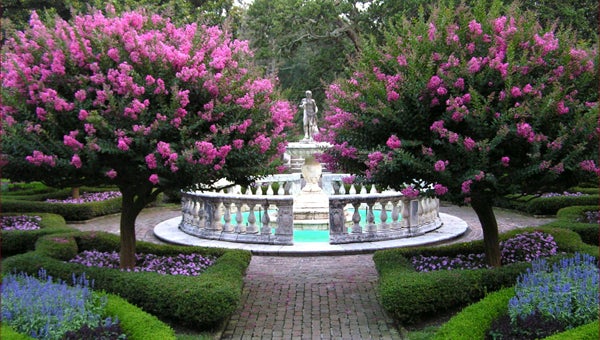101 Days of Southern Summer Blooms at The Elizabethan Gardens: Crepe Myrtles Enjoyed as Part of Design and Beauty of Outer Banks Garden
Published 9:59 am Saturday, July 25, 2015

ELIZABETHAN GARDENS
IN BLOOM: Pictured is the Elizabethan Gardens’ sunken garden, the central point or axis of renowned designers Innocenti and Webel’s designs for the garden.
From Elizabethan Gardens
Southerners have long had a love affair with Crepe Myrtles. And what’s not to love about them? They provide long-lasting color in the summer, have vibrant foliage in the fall and the architectural twists and turns of their trunk are striking in winter. It’s easy to see why renowned designers Innocenti and Webel featured them as part of the original plans for Manteo, North Carolina’s The Elizabethan Gardens in 1951.
When explaining his vision for these southern gardens, Webel exclaimed, “Having seen the actual site and having steeped myself into the garden lore and literature of Elizabethan times, I then visualized myself as one of the early settlers designing a garden on this very site. I found a beautiful bluff commanding a view over the bay with a lovely, sandy beach. Here then is the place for the garden!” And here then is a place that has grown into a lush showcase of nature’s beauty with seasonal blooms like the majestic Crepe Myrtle.
At this North Carolina garden you’ll find rich plumes of Crepe Myrtles alongside the main entrance with their smooth tornado-twisted trunks rising upward to yield exuberant branches of dense green leaves that finish with pink crepe-like blooms.
These vibrant-blooming deciduous trees are also a signature feature in the Sunken Garden – a walled garden at the heart of the site.
The sunken garden is the central point or axis of Innocenti and Webel’s design for The Gardens. This square area is a “garden within a garden” enclosed on all sides by a low, perforated wall of rustic handcrafted bricks. Inside these gardens, clipped Dwarf Yaupon Holly outlines 32 identical parterres. (Parterres is a French term for symmetrical beds in a formal garden separated by hedges or other landscaping elements.) These beds host a continuing parade of year-round color with ever-changing displays of ornamental plants that accentuate the open-aired museum of ancient statuary and ornamentals found here.
For decades, eight majestic watermelon-pink blooming Crepe Myrtle trees have framed the central focus – an ancient Italian two-tiered fountain of Aphrodite and pool with carved balustrade. The impressive renaissance statue of Carrara marble was a gift from the John Hay Whitney collection that was imported from Italy for his Georgia estate. Incidentally, the coat-of-arms in the fretted stonework is that of the powerful Farnesi family of 15th century Italy.
An eleven-foot-high pleached allee of Yaupon Holly with arched openings frames the statuary, Crepe Myrtles, formal beds and brick walls. (Pleached Allee is another French term for meticulously groomed walkway.) Native American Indians used the foliage of this native holly to brew a tea-like drink high in caffeine.
The sunken gardens represents the type of formal garden one would expect to see at the estate of the aristocracy in Elizabethan England, just as Webel envisioned.
Crepe Myrtle standards like the ones found here and at the garden entrance will typically bloom their small tufts of crepe flowers for an incredible 101 days
But you won’t find Crepe Myrtles growing this beautifully in the cool old world climate of England. These trees are best suited to the warmth of America’s southern states where they are prized for their beauty.
These trees have been a welcome addition to The Elizabethan Gardens and a sight to behold in their manicured setting. Here they stand as tribute and memorial to the ill-fated Elizabethan colonists who once walked these North Carolina shores. And millions of visitors have enjoyed them since The Elizabethan Gardens formally opened 55 years ago.





